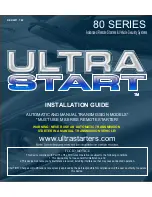
4
Information SET-02
11.3
Constructing your first Multi unit (MU) consist
29
11.4
Displaying the locomotive address within an MU
31
11.5
Controlling the speed and direction of a locomotive within a MU
32
11.6
Controlling functions of a locomotive within a MU
32
11.7
Removing a locomotive from a MU
32
11.8
Managing the LH200 MU memory
33
11.9
Preconditions for multi unit operation
33
12 Configuring your SET-02
34
13 Programming on the Programming Track
35
13.1
What is a programming track?
35
13.2
Difference between "programming using POM" and "programming
on the programming track"
35
13.3
When is it necessary to program on the programming track?
36
13.4
Where is the programming track connected?
36
13.5
Programming on the programming track" – step by step
instructions
37
14 Expanding SET-02
39
14.1
Adding an X-Bus to allow additional input devices
40
14.1.1 Special information on operating X-Bus-devices
41
14.2
More power through more power stations
42
14.2.1 Connecting additional LV200s to Set-02
42
14.3
Expanding beyond the capabilities of SET-02 using a LZ100
Command Station.
43
15 Technical Appendix
44
15.1
The LH200 stack
44
15.2
Messages on the display
45
15.3
Selecting a suitable transformer for Set-02
45
15.3.1 Permissible supply voltage (input voltage)
46
15.3.2 Voltage on the track (output voltage)
46
15.3.3 Output current available to the railroad
46
15.4
Power Station LV200
46
15.4.1 Connecting the LV200 to the layout
47
15.4.2 The luminous diode
48
15.4.3 Details of the six-pin I/O - port
48
15.4.4 Installation considerations
49
15.4.5 Connecting the LV200 to Other DCC Systems
49
15.5
Advice on the wiring of the model railway
50
15.5.1 Connecting a reverse loop
51
15.5.2 Common rail wiring
52
15.6
Mixed operation: conventional DC and digital DCC
52
15.7
Wiring the X-Bus
53
15.8
Programming using "Register-mode"
55
15.9
Bits and bytes – conversion help
56
15.10 Glossary
57
16 Troubleshooting Guide
58
17 Radio And Television Interference
60
18 Warranty
60





































